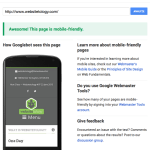In one of our most recent email newsletters, we pointed readers to Google’s Mobile-Friendly Test so that people could check to make sure their sites weren’t being penalized. This link was far and away the hottest item in the email, with over 400% more clicks than any other link in the newsletter.
In spite of Google’s attempts at emphasizing the importance of mobile-friendly design, and later on their tough-love warnings that your sites will be punished after April 21st, the message seems clear to us: people, businesses, and their websites are being left behind and many are unsure what to do to catch up.
Some may breathe a sigh of relief upon receiving a passing mark from the test, but what if you’re left with a big, fat F?
Over at our agency, The Next Wave, we commonly receive requests to “add responsiveness to our existing site.” We understand that this kind of request comes from a good place: folks who are looking for an inexpensive and painless way into the mobile-friendly realm by “adding on” the mobile functionality.
The problem is that this is actually pretty difficult, in some cases impossible, to achieve from a designer and developer’s perspective.
Mobile-friendly designers will typically start designing a website by how it looks like on mobile devices, then expanding and scaling the design outwardly from there. The idea is that everyone will be looking at essentially the same website, and there is no inferior way to browse.
Mobile-friendly developers mostly code websites as a giant grid to complement this aforementioned approach to design. For instance, each item on a typical WordPress site: posts, sliders, headlines, forms, and etc. are placed inside various squares of a grid. This makes it very easy to scale websites. As the screen becomes larger and smaller, you can shift the grid around so that everything still fits, but the code itself stays the same underneath.
Most developers who are giving an old site true responsiveness are essentially coding a new site from scratch but still wrapping it up in your design that looked good back in 2010. It makes more sense to just go back to the drawing board and start fresh.
By now I can feel your frustration coming through. You’re likely thinking, “This is all well-and-good, but I still can’t afford the time/money to invest in a brand new website right now.” You might even be thinking that there’s nothing wrong with your site as it is, except for Google’s stupid new rule.
If you’re a WordPress user, there are a few plugins out there that can take your pages, posts, etc. and wrap it in a separate mobile site. Notably WPTouch—with a couple free themes—and the mobile theme feature in Jetpack. Desktop users will still see your same-old site, and mobile users will be served up something different.
Keep in mind, however, that your mobile users will be looking at an inferior version of your site that might not work very well. Eventually, you’ll have to move on.
It’s not as intimidating as it seems, we promise. In fact, you could do it yourself over a long weekend. That’s what our seminar can show you.
You can be a Google star… you just have to write often, connect and know what you are talking about.
It’s nice when the New York Times writes about blog superstars like Mark Cuban- who gets thousands of comments on a post, but, what about the rest of us?
Everyone knows something about something- at least that’s the premise of Wikipedia. But, when it comes to getting that Google love, the Times has a few good tips:
So You Want to Be a Blogging Star? – New York Times
More to the point, linking to other bloggers is the best way to get them to link to you. Links from other bloggers increase your readership two ways: they send readers directly from other sites, and they raise your ranking in search engine results. A blogger who posts about a hot topic like Eliot Spitzer’s secret life, but has no inbound links, will lose out to one who already has dozens of inbound links from other sites.Plug yourself. That’s what all the name-brand bloggers do. It’s not bad form to send a short note to a prominent blogger drawing his or her attention to a really good blog you wrote. Some bloggers place links to their sites in comments they write on more established blogs. And some bloggers are on to the trick and refuse to allow it.
A more direct way to draw a crowd is to submit your blog posts to news aggregation sites like Digg, Fark and Boing Boing. Readers vote on how much they like the posts and new readers are drawn to the list of most popular posts. Granted, it helps if your blog post includes a home video of someone being attacked by a cat or really arrogant e-mail messages from a hedge-fund manager. Those get passed around virally in an instant.
You have to think about what you write, how useful it will be to your audience, and how to get connected with other sites. Finding your community and your voice can take a while, but once it’s there- lookout.
Of course, if you take the websitetology seminar, you’ll know a lot more about how all this works.



